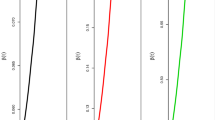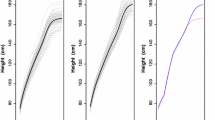Abstract
This paper investigates the hypothesis test of the parametric component in partial functional linear quantile regression model in which the dependent variable is related to both a vector of finite length and a function-valued random variable as predictor variables. A quantile rank score test based on functional principal component analysis is developed. Under mild conditions, we establish the consistency of the proposed test statistic, and show that the proposed test can detect Pitman local alternatives converging to the null hypothesis at the usual parametric rate. A simulation study shows that the proposed test procedure has good size and power with finite sample sizes. Finally, an illustrative example is given through fitting the Berkeley growth data and testing the effect of gender on the height of kids.

Similar content being viewed by others
References
Cai, T., & Hall, P. (2006). Prediction in functional linear regression. The Annals of Statistics, 34(5), 2159–2179.
Cardot, H., Crambes, C., & Sarda, P. (2005). Quantile regression when the covariates are functions. Journal of Nonparametric Statistics, 17(7), 841–856.
Cardot, H., Ferraty, F., & Sarda, P. (2003). Spline estimators for the functional linear model. Statistica Sinica, 13(3), 571–592.
Chen, K., & Müller, H. G. (2012). Conditional quantile analysis when covariates are functions, with application to growth data. Journal of the Royal Statistical Society: Series B (Statistical Methodology), 74(1), 67–89.
Chen, C., & Wei, Y. (2005). Computational issues for quantile regression. Sankhyā: The Indian Journal of Statistics, 67(2), 399–417.
Chiou, J. M., & Li, P. L. (2007). Functional clustering and identifying substructures of longitudinal data. Journal of the Royal Statistical Society: Series B (Statistical Methodology), 69(4), 679–699.
Crambes, C., Kneip, A., & Sarda, P. (2009). Smoothing splines estimators for functional linear regression. The Annals of Statistics, 37(1), 35–72.
Ferraty, F., & Vieu, P. (2006). Nonparametric functional data analysis: Theory and practice. New York: Springer.
Gutenbrunner, C., Jurĕcková, J., Koenker, R., & Portnoy, S. (1993). Tests of linear hypotheses based on regression rank scores. Journaltitle of Nonparametric Statistics, 2(4), 307–331.
Hall, P., & Horowitz, J. L. (2007). Methodology and convergence rates for functional linear regression. The Annals of Statistics, 35(1), 70–91.
Hall, P., Müller, H. G., & Wang, J. L. (2006). Properties of principal component methods for functional and longitudinal data analysis. The Annals of Statistics, 34(3), 1493–1517.
Hall, P., Müller, H. G., & Yao, F. (2009). Estimation of functional derivatives. The Annals of Statistics, 37(6A), 3307–3329.
He, X., & Shao, Q. M. (2000). On parameters of increasing dimensions. Journal of Multivariate Analysis, 73(1), 120–135.
Horváth, L., & Kokoszka, P. (2012). Inference for functional data with applications. New York: Springer.
Kai, B., Li, R., & Zou, H. (2011). New efficient estimation and variable selection methods for semiparametric varying-coefficient partially linear models. The Annals of Statistics, 39, 305–332.
Kato, K. (2012). Estimation in functional linear quantile regression. The Annals of Statistics, 40(6), 3108–3136.
Kocherginsky, M., He, X., & Mu, Y. (2005). Practical confidence intervals for regression quantiles. Journal of Computational and Graphical Statistics, 14(1), 41–55.
Koenker, R. (2005). Quantile regression. New York: Cambridge University Press.
Li, Y., & Guan, Y. (2014). Functional principal component analysis of spatiotemporal point processes with applications in disease surveillance. Journal of the American Statistical Association, 109(507), 1205–1215.
Lu, Y., Du, J., & Sun, Z. (2014). Functional partially linear quantile regression model. Metrika, 77(3), 317–332.
Ramsay, J. O., Bock, R. D., & Gasser, T. (1995). Comparison of height acceleration curves in the Fels, Zurich, and Berkeley growth data. Annals of Human Biology, 22(5), 413–426.
Ramsay, J. O., & Silverman, B. W. (2002). Applied functional data analysis: Methods and case studies. New York: Springer.
Ramsay, J. O., & Silverman, B. W. (2005). Functional data analysis (2nd ed.). New York: Springer.
Reiss, P. T., & Ogden, R. T. (2007). Functional principal component regression and functional partial least squares. Journal of the American Statistical Association, 102(479), 984–996.
Shin, H. (2009). Partial functional linear regression. Journal of Statistical Planning and Inference, 139(10), 3405–3418.
Tuddenham, R., & Snyder, M. (1954). Physical growth of California boys and girls from birth to eighteen years. California Publications on Child Development, 1, 183–364.
Wang, H. J., & He, X. (2007). Detecting differential expressions in GeneChip microarray studies: A quantile approach. Journal of the American Statistical Association, 102(477), 104–112.
Wang, H. J., Zhu, Z., & Zhou, J. (2009). Quantile regression in partially linear varying coefficient models. The Annals of Statistics, 37(6), 3841–3866.
Wu, Z., & Hitchcock, D. B. (2016). A Bayesian method for simultaneous registration and clustering of functional observations. Computational Statistics & Data Analysis, 101, 121–136.
Yao, F., Fu, Y., & Lee, T. C. M. (2011). Functional mixture regression. Biostatistics, 12(2), 341–353.
Yao, F., Müller, H. G., & Wang, J. L. (2005). Functional linear regression analysis for longitudinal data. The Annals of Statistics, 33(6), 2873–2903.
Yuan, M., & Cai, T. (2010). A reproducing kernel Hilbert space approach to functional linear regression. The Annals of Statistics, 38(6), 3412–3444.
Yu, P., Zhang, Z., & Du, J. (2016). A test of linearity in partial functional linear regression. Metrika, 79(8), 953–969.
Acknowledgements
Du’s work is supported by the National Natural Science Foundation of China (11971045), the Science and Technology Project of Beijing Municipal Education Commission (KM201910005015), Young Talent program of Beijing Municipal Commission of Education (CIT&TCD201904021), and China Postdoctoral Science Foundation Funded Project (2019M653502). Zhang’s work is supported by the National Natural Science Foundation of China (11771032).
Author information
Authors and Affiliations
Corresponding author
Additional information
Publisher's Note
Springer Nature remains neutral with regard to jurisdictional claims in published maps and institutional affiliations.
Appendix 1
Appendix 1
In order to provide the proofs of the theorems, we first define some notations and give some preliminary results.
Write \({\hat{V}}_k(g)=\sum _{j=1}^m\frac{\langle {\hat{C}}_{z_kX},{\hat{v}}_j\rangle \langle {\hat{v}}_j,g\rangle }{{\hat{\lambda }}_j}\), \(V_k(g)=\sum _{j=1}^{\infty }\frac{\langle C_{z_kX},v_j\rangle \langle v_j,g\rangle }{\lambda _j}\) for \(g\in L^2[0,1]\), \(\hat{\varvec{\Delta }}={\hat{C}}_{\varvec{z}}-\{{\hat{V}}_k({\hat{C}}_{z_{l}X})\}_{k,l=1,\ldots ,p}\). Then it is easy to show that \(\varvec{\Delta }\) defined in condition C6 can be expressed as \(\varvec{\Delta }=C_{\varvec{z}}-\{{V_k(C_{z_{l}X})}\}_{k,l=1,\ldots ,p}\), and that \(\hat{\varvec{\Delta }}=\frac{1}{n}\varvec{Z}^T(\varvec{I}-\varvec{P})\varvec{Z}=\frac{1}{n}{\varvec{Z}^*}^T{\varvec{Z}^*}\) if \({\hat{\lambda }}_1>\cdots>{\hat{\lambda }}_n>0\) holds. Let \(\varvec{S}^*_n=\frac{1}{\sqrt{n}}\sum _{i=1}^{n}\varvec{z}_i^*\psi _\tau ({\epsilon }_i)\), \(R_i=\int _{0}^{1}\gamma _0(t)X_i(t)dt-\varvec{U}_i^T\varvec{\gamma }_0\), \(\delta =n^{-\frac{2b-1}{2(a+2b)}}\).
The following Lemma 1, which is from He and Shao (2000, Lemma 3.2), is presented here for easy reference.
Lemma 1
Let \(\{v_i(t), t\in R^q\},\;1\le i\le n\), be independent \(R^d\)-valued random variables with \(E\{v_i(t)\}=0\) for all t. Assume that there exist \(r_1>0\) and \(r_2>0\) such that for every \(s\in R^q\), \(0<\delta ^*\le 1\), \(1\le i\le n\)
Let
and
Then
for every \(r_3\ge 0\).
Lemma 2
Let \(u_i(\varvec{\gamma },\varvec{\gamma }_0)=\psi _\tau (Y_i-\varvec{U}_i^T\varvec{\gamma })\varvec{z}_i^*-\psi _\tau (Y_i-\varvec{U}_i^T\varvec{\gamma }_0)\varvec{z}_i^* -E\psi _\tau (Y_i-\varvec{U}_i^T\varvec{\gamma })\varvec{z}_i^*+E\psi _\tau (Y_i-\varvec{U}_i^T\varvec{\gamma }_0)\varvec{z}_i^*\). Under the regularity conditions of Theorem 1, for any \(L>0\), it has
Proof
We prove this lemma using Lemma 1. First, we verify the condition in (13), that is, there exist \(\nu\) and \(r>0\) such that
Noting that \(I(\epsilon \le \cdot )\) and \(F(\cdot )\) are monotone increasing functions, \(\psi _\tau (u)=\tau - I(u<0)\) is a step function with a jump at \(u=0\), \(\Vert \varvec{z}_i^*\Vert =O_p(1)\) and \(\Vert \varvec{U}_i\Vert =O_p(1)\), a simple calculation yields
which implies (15).
Second, it holds that
thus, we have
which implies
Moreover, we can get
Invoking Lemma 1 and Condition C2(b), we have
This completes the proof of Lemma 2. \(\square\)
Lemma 3
Under the regularity conditions of Theorem 1, for any \(L>0\), it has
Proof
Since \(E\psi _\tau (\epsilon )=\tau -F(0)=0\), where F is the conditional distribution function of \(\epsilon\). Using the Taylor expansion, we have
The remainder is \(o\big (1/\sqrt{n}\big )\) because \(\Vert \varvec{\gamma }-\varvec{\gamma }_0\Vert \le L\delta\) and \(b>\frac{a}{2}+1\). Then, we can obtain that
where \(b=f(0)\) and \(c=f'(0)\). Note that \(\varvec{U}\) and \(\varvec{Z}^*\) are orthogonal to each other, that is, \(\varvec{U}^T\varvec{Z}^*=0\). Moreover,
Thus completes the proof of Lemma 3. \(\square\)
Proof of Theorem 1
First, note that
For \(\text {A}_1\), by condition C1 and the Hölder inequality, it follows
As for \(\text {A}_2\), due to
and
one has
Taking these together, we have
According to Theorem 3.2 of Kato (2012), we can get the fact that \(|\hat{\varvec{\gamma }}-\varvec{\gamma }_0|=O_p(\delta )\). Therefore, we can derive from Lemmas 2 and 3 that
Moreover, invoking Eq. (17) and following the similar arguments used for Eq. (18), a simple calculation yields
Combining (18) and (19), we have
In addition, it’s easy to see that
By the central limit theorem, we have
Then, Theorem 1 follows immediately from (20) and (21). \(\square\)
Lemma 4
Define
where \(\hat{\varvec{\gamma }}=\text {argmin}_{{\varvec{\gamma }}\in R^m}\sum _{i=1}^{n}\rho _\tau (Y_i-\varvec{U}_i\varvec{\gamma }-\varvec{z}_i^T\frac{\varvec{\beta }_0}{\sqrt{n}})\). Then under \({\widetilde{H}}_A\) and Conditions C1–C7, we have
Proof
Since \(E\psi _\tau (\epsilon )=\tau -F(0)\) and
Then, invoking (17) and the orthogonality between \(\varvec{U}\) and \(\varvec{Z}^*\), we have
This completes the proof of Lemma 4. \(\square\)
Proof of Theorem 2
According to Lemma 1 in Yu et al. (2016), we have
Note that \({\varvec{{S}}}_n^*\) is the summation of independent entries. It follows from the Lindberg-Feller central limit theorem that
The combination of (23), (24), Lemma 4 and the definition of non-central Chi-squared distribution allow us to finish the proof of Theorem 2. \(\square\)
Rights and permissions
About this article
Cite this article
Yu, P., Du, J. & Zhang, Z. Testing linearity in partial functional linear quantile regression model based on regression rank scores. J. Korean Stat. Soc. 50, 214–232 (2021). https://doi.org/10.1007/s42952-020-00070-9
Received:
Accepted:
Published:
Issue Date:
DOI: https://doi.org/10.1007/s42952-020-00070-9
Keywords
- Functional data analysis
- Functional linear quantile regression
- Functional principal component analysis
- Rank score test




